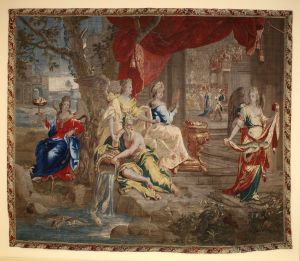MUO-014862: Tapiserija "Zima": tapiserija
Inventarna oznaka
MUO-014862
Naziv zbirke
Autor (osoba)
Autorska radionica (proizvođač)
Književni naziv
Dodatak nazivu
Naslov predmeta
Tapiserija "Zima"
Država nastanka
Grad nastanka
Godina nastanka
oko 1700.
Materijal izrade
Tehnika izrade
Dimenzije (v1xš1xd1)
332 × 378 cm
Opis predmeta
Tapiserija s alegorijskim prikazom Zime pripada seriji pod nazivom Četiri godišnja doba, od koje Muzej posjeduje još i Jesen. Izrađena je u manufakturi Pietera van der Hecka, prema kartonima Ludwiga van Schoora (1666. - 1726.), u vrijeme kada je briselska proizvodnja tapiserija bila pod izrazitim utjecajem Rubensa.
U središtu kompozicije su ženski krilati lik – alegorija mjeseca siječnja i bradati muškarac koji predstavlja zodijakalni znak Vodenjaka. Ženski lik desno, koji sjedi uz pozlaćenu posudu s vatrom, personificira zimu; krilati lik lijevo prikazan je s jarcem – zodijačkim znakom mjeseca prosinca. Sasvim desni, izdvojeni ženski lik – personifikacija mjeseca veljače, prikazan je sa svojim zodijačkim znakom – ribama. Izvorno je bordura imitirala okvir slike s malim ugaonim školjkastim kartušama i nizom jako povijenih listova akantusa. Međutim, na ovoj tapiseriji ona je naknadno sužena na sve četiri strane, te je tako izrezana signatura koja se u pravilu nalazi uz borduru. Vrlo slična tapiserija s identičnim ikonografskim sadržajem nalazi se u Muse´es Royaux d’Art et d’Histoire u Bruxellesu.
Tapiserija je bila u dvorcu Pribislavcu kraj Čakovca. U muzejskom fundusu nalazi se od 1919. godine.
Ključne riječi
MUO baza
Autorska prava / Prava korištenja
